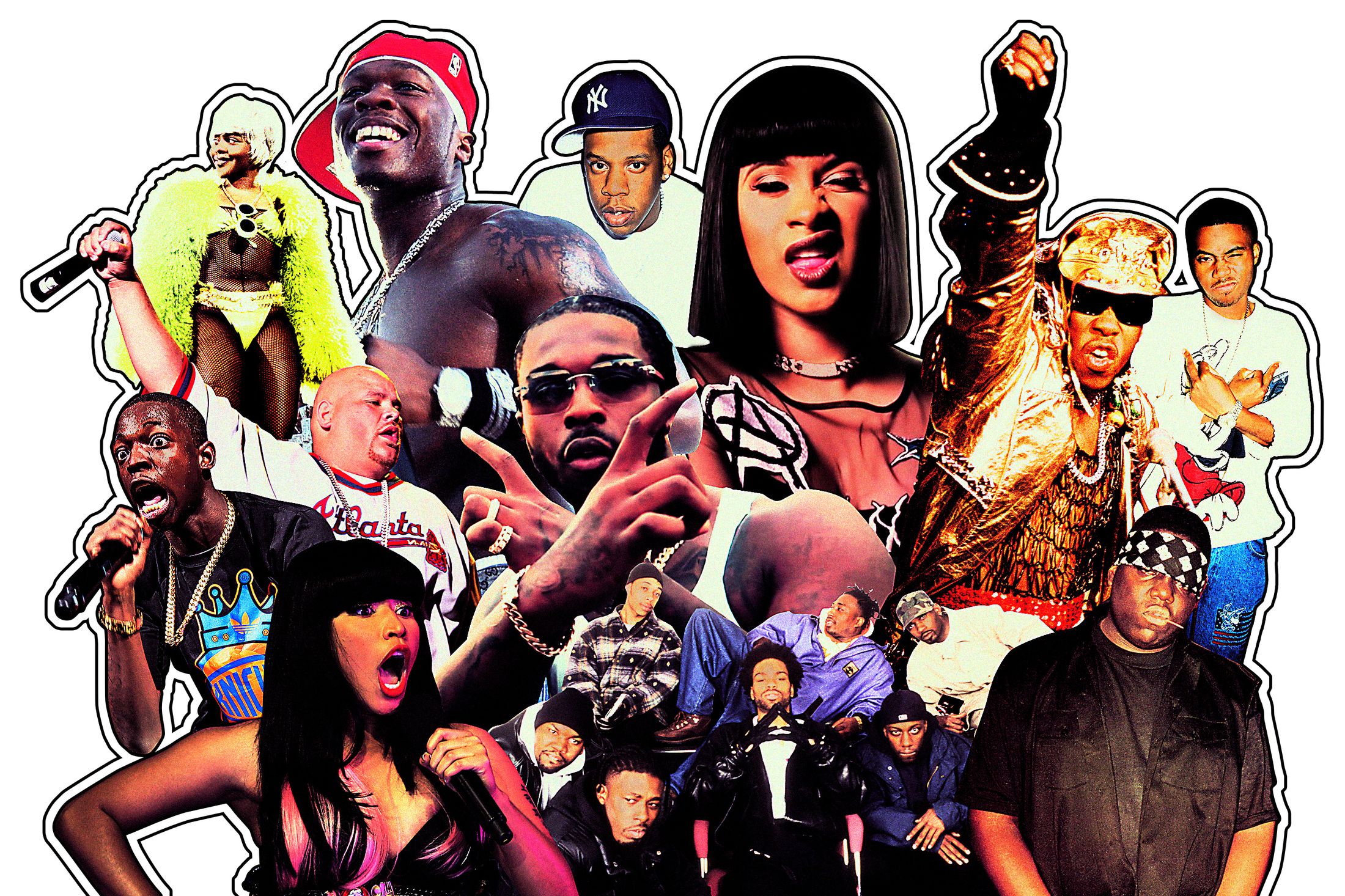
The 100 Songs That Define New York Rap, Ranked
It’s not a sound, it’s an attitude.
by William E. Ketchum III, Craig Jenkins, Dee LockettHip-hop started out in the parks and traveled around the globe and back, picking up new accents and flavors in every region and time zone, rubbing elbows with other genres and cultures, and adapting to new climates and temperaments. But the spark that inspired the early bombers, breakers, DJs, and rappers to revolutionize art, dance, fashion, music, and language endures in New York City, changing alongside the advancing generations. When kids in the Bronx needed party music to distract from the violent tumult of the rocky ’70s, DJ Kool Herc figured out how to extend the climaxes of funk records, making long and euphoric vamps out of sweet seconds of ecstasy. Drum-machine fanatics took after forward-thinking auteurs like Prince and Miles Davis, assembling clattering, inhuman percussion parts that would lead to epochal early-’80s gems like Run-DMC’s “Sucker M.C.’s (Krush-Groove 1).” A happy studio accident in the late ’80s inspired Queens native and Cold Chillin’ crew member Marley Marl to invent the art of sampling, setting the stage for the plush jazz-rap stylings of acts like A Tribe Called Quest and the abrasive kung fu rap of the Wu-Tang Clan in the ’90s as well as the triumphant sounds of the Diplomats’ “Dipset Anthem” and Jay-Z’s “Public Service Announcement” in the next decade. As regionalism in rap began to ebb and artists from the East, South, West, Midwest, and overseas began trying out one another’s wares, stars like 50 Cent — and later Nicki Minaj — dominated via annexation, picking and choosing bits of popular sounds and fashions to graft onto their formidable arsenals of tricks.
To decide the “best” of New York rap would only tell half the story — an uneven one — so instead, we invited a team of writers to rank a new type of local canon: 100 songs that capture a bigger picture of the sound of the city. Old heads will tell you that New York rap is a distinct sound rooted in the thunder-and-lightning interplay between kick and snare drums in an East Coast boom-bap track, but really, it’s an attitude, a way to be. It’s the noisy, flashy style Harlem folks pick up across 125th Street and the gruff, no-nonsense speech of Brooklynites, the insular slang of the Queensbridge projects and the versatile blend of cultures you see in a trip through the Bronx. The enduring spirit of New York hip-hop is unbridled confidence, limitless audacity. It manifested itself through aspiring musicians boosting sound systems during the 1977 blackout, then turning into professional DJs seemingly overnight; through Run-DMC securing the first rap endorsement deal after repping shell-toe Adidas so hard in their music; through a 14-year-old Roxanne Shanté flaming UTFO in “Roxanne’s Revenge”; through Raekwon’s mob epics and Ghostface’s psychedelic crime stories; through Cam’ron getting shot three times and driving himself to the hospital in a Lamborghini, dripping in diamonds; through Jadakiss’s devilish signature laugh and Azealia Banks’s withering snark; through Bobby Shmurda’s gravity-defying hat and Pop Smoke’s guttural snarl.
The spirit of New York hip-hop springs eternal. Real heads know.
—Craig Jenkins
data-uri="www.vulture.com/_components/concert-ads/instances/general@published"
100. EPMD, “You Gots to Chill” (1988)
Erick and Parrish take the laid-back cool of Rakim and make it sound even icier on this cooler-than-thou classic. Over a brilliant Roger Troutman flip that highlights Sermon’s considerable production talent, the dynamic duo get down. A timeless single that came to embody hip-hop’s golden age. —Stereo Williams
99. Whodini, “Friends” (1984)
If Larry Smith’s instrumental for “Friends” had come out today, it would still sound like it was beamed in from the future. Smith’s work, including with Run-D.M.C., is underappreciated for its ability to take the synthetic sounds of ’80s pop and reconfigure them to rattle your bones. —Paul Thompson
98. Grandmaster Flash & the Furious Five, “New York New York” (1983)
Though the gangsta rappers who emerged later in the decade would take the flak for promoting illegal activity in their music, Melle Mel and his Sugar Hill cohort Duke Bootee speak bluntly here about the criminality, poverty, and sheer desperation of being Black in the city in the 1980s. As bleak as its lyrics are, it was a minor hit. —Gary Suarez
97. A$AP Rocky, “Peso” (2011)
A$AP Rocky, a known lover of Houston’s chopped-and-screwed scene, used his outside influences to create “Peso,” a song that plays off the trillness of his “Purple Swag.” While reppin’ Harlem, the pretty motherfucker laid out what the A$AP Mob was about: high-end designers, smoking sections, and getting to the money. —Eric Diep
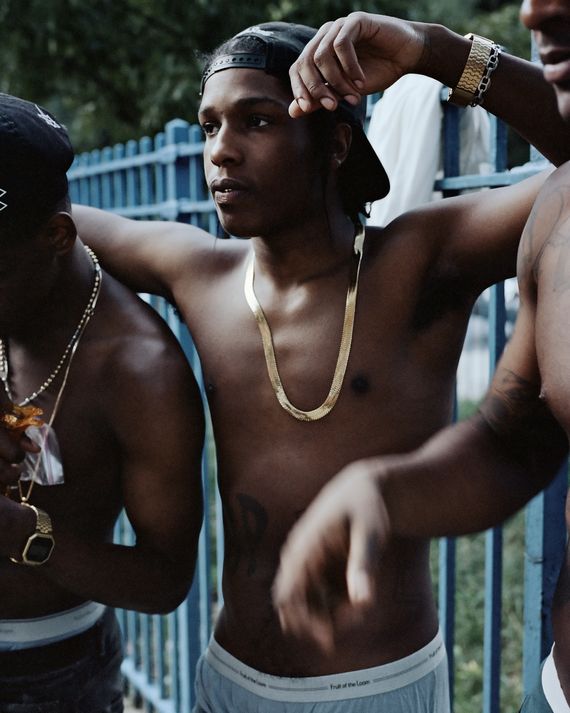
96. A$AP Ferg ft. A$AP Rocky, “Shabba” (2013)
Though fashion killa Rocky seemed the likeliest member of the hip-hop collective A$AP Mob to succeed in the Harlem set, this dancehall-nodding single by his boisterous consigliere proved so popular that it turned a mixtape drop into an album release. The titular loverman would later grace its remix alongside Busta Rhymes and two-out-of-three Migos. —Gary Suarez
95. Method Man, “Bring the Pain” (1994)
He’d broken out big on Wu-Tang Clan’s first album, and this dark masterpiece announced M-E-T-H-O-D Man as his own unique kind of star. The beat was gutter enough for the streets but hooky enough for the radio, and Meth’s legend and image were cemented with that white contact lens in the video. —Stereo Williams
94. T La Rock and Jazzy Jay, “It’s Yours” (1984)
This track is the Def Jam origin story. The Bronx rapper’s sparse 808 kick and DJ-scratch-centered 12-inch debuted the label’s iconic logo, caught talent manager Russell Simmons’s attention, and inspired a 16-year-old LL Cool J to send his demo to the address he found on the LP sleeve, birthing a legacy. —Naima Cochrane
93. Beastie Boys, “No Sleep Till Brooklyn” (1986)
A turning point not just for rap locally but culturally, Licensed to Ill married rock and rap more organically than “Walk This Way” had done earlier in the year. MCA, Mike D, and Ad-Rock were a trio of white dudes from the then-lesser-loved Brooklyn borough who had punk in their blood but a natural sensibility for hip-hop — refined by Def Jam sensei Rick Rubin and the group’s first manager, Russell Simmons. Inspired by Motörhead, nights at the famed Flatiron club Danceteria, and more nights on the road, “No Sleep Till Brooklyn” was one of the earliest signs that rap could and would travel far but would always come home to New York. —Dee Lockett
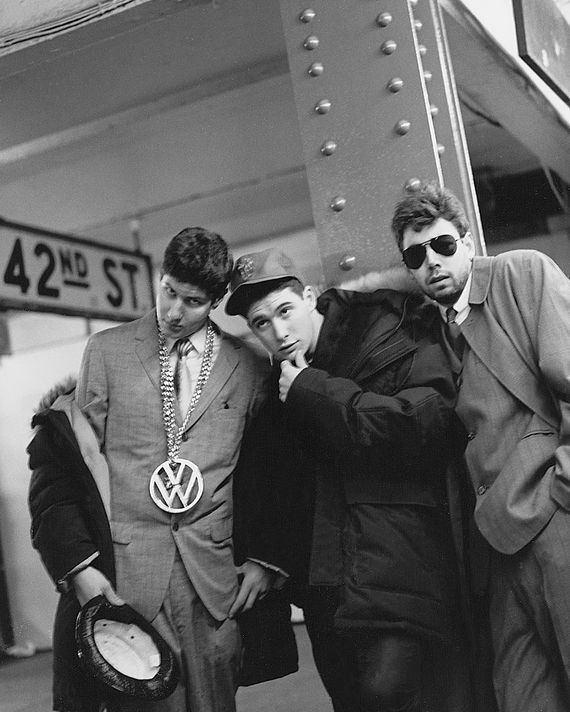
92. Run-D.M.C., “Peter Piper” (1986)
“Goddamn, that DJ made my day!” Run and D.M.C. do their thing with the rap-ification of fairy tales and fables, but “Peter Piper” is a Jam Master Jay master class. It’s hip-hop as the originators intended: two dynamic MCs volleying like a tennis match over a classic breakbeat as the DJ cuts and mixes it up. There it is. —Naima Cochrane
91. Biz Markie, “Nobody Beats the Biz” (1988)
Retailer the Wiz, whose jingle Biz flipped for this hook, is all but forgotten. But this Marley Marl production spurred a family tree of samples — both track and lyrics — that reads like a list of hip-hop’s greats. “Just a Friend” is a fave, but this one features Biz’s famous beatbox, falsetto singing, plus an effortless flow with quotables for days. —Naima Cochrane
90. 50 Cent, “Wanksta” (2002)
50 Cent’s entry into mainstream success came with the release of “Wanksta,” a song about fake gangstas who talk a lot but don’t back up their words. Originally on his 2002 mixtape No Mercy, No Fear, it blew up on the 8 Mile soundtrack later that year, and the single, produced by Sha Money XL and J-Praize, reached No. 13 on the Hot 100. It also delivered a new word to the hip-hop-culture lexicon. —Starr Rhett Rocque
89. Fat Joe ft. Ashanti and Ja Rule, “What’s Luv?” (2002)
Some songs just sound so indisputably 2002. Although Terror Squad’s “Lean Back” is often remembered as Fat Joe’s commercial crossover, its flirty, lighter predecessor “What’s Luv?” put Fat Joe on the map well beyond the Bronx two years earlier. But really, “What’s Luv?” is as much an Irv Gotti story as anything—a testament to the Queens label mogul’s correct call that most 2000s hip-hop hits were going to need some winning combo of Fat Joe, Ashanti, and Ja Rule. —Dee Lockett
88. Nicki Minaj, “Itty Bitty Piggy” (2009)
When Nicki Minaj’s rap reign started, New York was “returning” with an unlikely leader. In true NYC theater-kid, golden-era-rap, ’80s-baby fashion, the MC subverted a nursery rhyme into a braggadocio, bar-filled banger. From her mixtape-era masterpiece Beam Me Up Scotty, “Itty Bitty Piggy” marked the start of Nicki’s decade of dominance and set the foundation for a new generation of hip-hop. —Ivie Anie
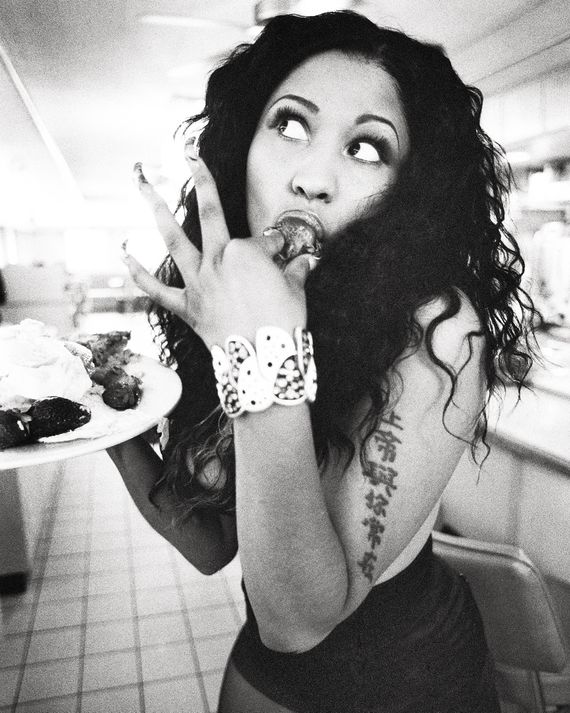
87. Eric B. & Rakim, “I Ain’t No Joke” (1987)
In many ways, there’s rap before Rakim and hip-hop after him: The God MC’s internal rhyme schemes in the late ’80s showed new capabilities for lyricism. “I Ain’t No Joke,” the second single from his and Eric B.’s debut, Paid in Full, changed the way rappers would rap — and Eric B.’s precise scratches are as hip-hop as it gets. —William E. Ketchum III
86. Chinx ft. French Montana, “I’m a Coke Boy” (2012)
In homage to underrated Queens rapper Royal Flush, the pair flip his “Worldwide” beat into a boastful paean to dope spots and strip joints. A local anthem prior to Chinx’s 2015 death, it cemented the Coke Boys, one of New York’s crucial rap movements, prompting a remix with Diddy and Rick Ross. —Gary Suarez
85. Jay-Z ft. UGK, “Big Pimpin’” (1999)
The ’90s ushered in both the rise of the South, which demanded acknowledgment of its contributions to hip-hop, and the emergence of the video vixen. It was only natural, then, that the Roc-A-Fella duo of Dame Dash and Jay-Z would extend an olive branch to UGK, one of the fastest-rising duos from Texas at the time, to collaborate on the biggest single of Jay-Z’s fourth album, Vol. 3… Life and Times of S. Carter. The song almost didn’t happen, however: Reluctant to collaborate with Jay, Pimp C didn’t submit his verse until the 11th hour, even delaying participating in his now-infamous music-video scene with Gloria Velez. (He ultimately had to film in Miami in lieu of Trinidad’s Carnival, the backdrop for the rest of the crew.) —Shamira Ibrahim
84. Wu-Tang Clan, “Protect Ya Neck” (1992)
Labels didn’t believe a rap group made of distinctive solo acts could work. Collectives and crews who hopped on occasional posse cuts? Easy. A group of MCs with such different styles? Nah. “Protect Ya Neck” descended on hip-hop like the swarm of killer bees that Shaolin’s finest likened themselves to — jarring, noisy, a little scary, but fascinating to watch working together. —Naima Cochrane
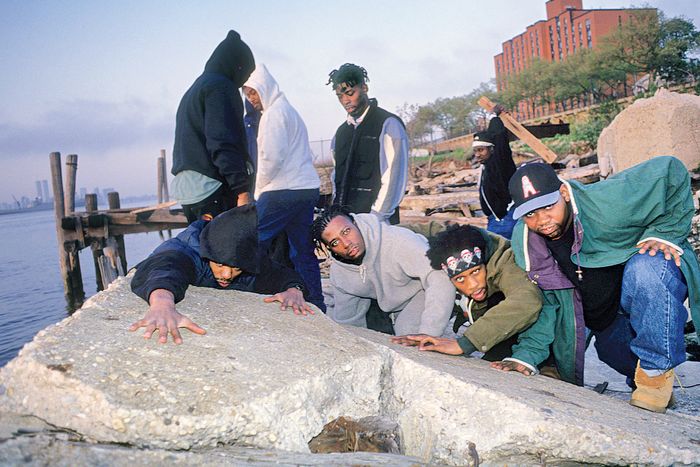
83. Big Pun ft. Tony Sunshine, “100%” (2000)
Interpolating Willie Colón and the late legend Héctor Lavoe’s classic “El Día de Mi Suerte,” Big Pun gave New York a new anthem for the ages. More than the default soundtrack to the annual Puerto Rican Day Parade, it surfaced Pun’s dexterity in pumping out radio hits while channeling the pulse of the streets and showed the continuity of Latinx presence and influence in hip-hop. —Ivie Anie
82. Jay-Z ft. Mary J. Blige, “Can’t Knock the Hustle” (1996)
If Reasonable Doubt is a movie, Jay and Mary’s collaboration serves as its opening credits. This is proto-bling-era mafioso rap, the street hustler graduated to big boss, and a story told in a private room while drinking premium liquor as ’80s soul plays in the background. A New York anthem in its own right. —Naima Cochrane
81. Ultramagnetic MCs, “Ego Trippin’” (1986)
An uncredited producer on Boogie Down Productions’ Criminal Minded and a direct influence on the Bomb Squad’s Public Enemy work, Ced-Gee kept that same energy for his own crew’s music. As if that weren’t enough, this single introduced the world to the inimitable and individualistic cult rap icon Kool Keith, whose esoteric lyrical technique would serve him well in a lengthy underground solo career. —Gary Suarez
80. The Firm, “Phone Tap” (1997)
“Phone Tap” is mob business. Sinister, tense, and seriously paranoid — courtesy of some of Dr. Dre’s finest production — it’s the standout from the lone album by the short-lived (but recently sort of reunited) supergroup the Firm, which at one point included local legends Nas, Foxy Brown, AZ, and Cormega (the latter eventually replaced by Nature). Their eponymous 1997 debut was largely considered a flop for failing to coalesce, but “Phone Tap” remains one of the truest sounds of the New York underbelly, a conversation between Nas and AZ in which they attempt to plot undetected. (Spoiler: Dre’s on the line, foiling all their plans.) —Dee Lockett
79. A Tribe Called Quest, “Electric Relaxation” (1993)
A Tribe Called Quest at their most sublime, in a song that came to epitomize the legendary Queens crew. Phife Dawg and Q-Tip’s laid-back genius coasts over and permeates that perfect Ronnie Foster sample. Fun fact: Phife shared that Q-Tip came up with the mesmerizing beat in Phife’s grandmother’s basement. —Stereo Williams
78. De La Soul, “Buddy” Remix (1989)
The Native Tongues were a singular collective in hip-hop, and though their members’ respective acts were already established, the “Buddy” remix and video are the centerpiece of the Africa-medallion-wearing conscious consortium’s legacy. “Buddy” is more than a classic posse cut; it’s the visual representation of a movement. —Naima Cochrane
77. Salt-N-Pepa, “Push It” (1987)
Salt-N-Pepa popped rap’s macho bubble the moment they entered the metaphorical ring. It was the first time a group of women had entered the mainstream as rappers — and they had a girl DJ in tow, also rare. Sugar Hill Records had previously tried to launch an all-girl rap trio, the Sequence, in the late ’70s, but that was a short-lived endeavor. “Push It” broke through during a time when only male rappers had begun dominating the charts. They were fierce and fearless but also sexy and feminine: They literally pushed the culture forward by delivering a new dance and new style possibilities with catsuits, lopsided bobs, and oversize leather bomber jackets, while showcasing that women could be viable hip-hop stars. “Push It” led to Salt-N-Pepa becoming the first female rap act — group or solo — to go platinum. —Starr Rhett Rocque
76. N.O.R.E., “Superthug” (1998)
With one single and a comically bizarre video, N.O.R.E. not only established himself as a viable solo act after Capone-N-Noreaga but put the still-obscure Virginia production duo of Pharrell Williams and Chad Hugo, known as the Neptunes, on the map — gaining them the attention of none other than Michael Jackson. This song single-handedly created waves across genres, and Pharrell would go on to lay his fingerprints across some of pop culture’s biggest hits from Britney to Beyoncé, and more or less trademarked N.O.R.E.’s “what what!” catchphrase as a New York rap siren. —Shamira Ibrahim
75. Salt-N-Pepa, “Let’s Talk About Sex” (1991)
In this highlight from their album Blacks’ Magic, Salt-N-Pepa tell straightforward stories about two women: one who feels empty after using sex to get what she wants, and another who has unprotected sex and thinks she’s safe from pregnancy but catches an STD. It’s all done with a melodic hook that’s as memorable as a song like their previous hit “Push It.” The trio don’t demonize sex, but they used their platform to educate and empower women — and their legacy is better for it. —William E. Ketchum III
74. Pop Smoke, “Welcome to the Party” (2019)
“Welcome to the Party” was proof that Pop Smoke’s grind was starting to pay off, and it put Brooklyn drill on the map. The U.K.-grime-infused tune coupled with Smoke’s baritone and unconventional delivery captivated everyone from the streets of Brooklyn to the rest of the world. —Starr Rhett Rocque
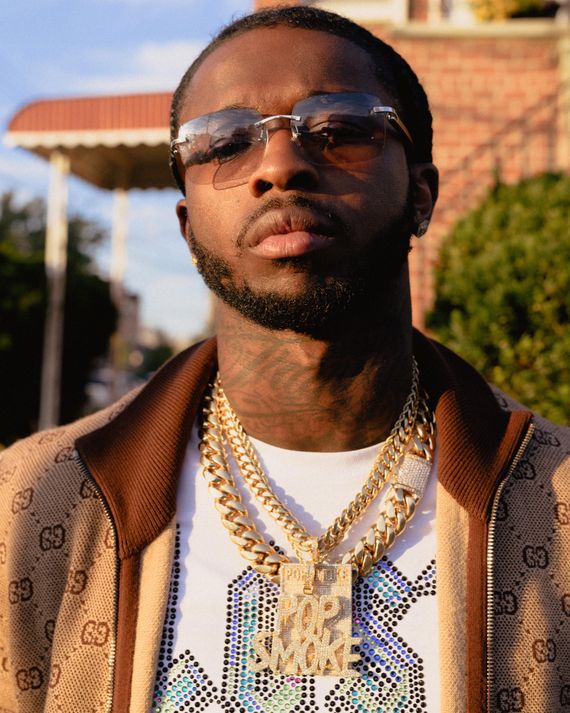
73. Black Sheep, “The Choice Is Yours (Revisited)” (1991)
Hearing the nursery-rhyme-esque lyrics “Engine engine No. 9 / On the New York transit line / If my train falls off the track” probably signals you to get in a crouched position and be prepared to spring up and shout, “Pick it up, pick it up, pick it up!” with all your might. That’s the power of this track, even 30 years later. —Naima Cochrane
72. Eric B. & Rakim, “Juice (Know the Ledge)” (1992)
It’s a dark, dramatic, and gripping narrative of a gangsta who meets his demise. One of the best story raps from an MC that still sets a standard, this classic theme song from 1992’s film Juice was one of the final high points for a duo that reinvented hip-hop over the course of four albums. The God MC at his absolute peak. —Stereo Williams
71. 50 Cent, “How to Rob” (1999)
50 Cent was just coming off of his mixtape buzz when he delivered this stickup-kid anthem as his first single on Columbia Records. Under the tutelage of Jam Master Jay, 50 Cent was poised to be the next grimey sensation out of Queens. This hilarious ode to robbing celebrities, with the Madd Rapper (Deric Angelettie) on the hook and production by Trackmasters, gave us a preview of the trolling that was to come. In hip-hop, you never call anyone out unless you want beef, but 50 Cent’s bold (and humorous) name dropping reenergized the game and showed that there were still commercial rappers who weren’t too pop to play the game of the streets. Ironically, several of the rappers he called out eventually ended up working with him. —Starr Rhett Rocque
70. MF DOOM, “Doomsday” (1999)
After the death of his brother DJ Subroc brought their rap group, KMD, to a tragic end, the rapper Zev Love X rebuilt his image in mourning and, in the process, spawned a hooded supervillain. Swapping out Gas Face for Metal Face, the comic-book-inspired persona acknowledges his past on the hook of this standout from Operation: Doomsday while laying waste to anything in his path on the verses. —Gary Suarez
69. Jay-Z and the Notorious B.I.G., “Brooklyn’s Finest” (1996)
A complementary and competitive exchange from two of hip-hop’s most skilled lyricists, “Brooklyn’s Finest” appears on Jay-Z’s debut album, Reasonable Doubt, and shows the then-rising rapper earning his spot next to a star. The MCs traded unwritten bars with a similar style of genius. —Ivie Anie
68. A Tribe Called Quest, “Check the Rhime” (1991)
On the first single from The Low End Theory, Q-Tip and Phife Dawg reminisce about kicking rhymes and practicing their stage presence on Linden Boulevard in Jamaica, Queens. The casual, laid-back mood brings out the duo’s chemistry. Both are on point all the time, but Phife stands out with his memorable verse. —Eric Diep
67. The LOX ft. Lil’ Kim and DMX, “Money, Power & Respect” (1998)
Shortly before World War I, German sociologist Max Weber philosophized a three-component theory of social stratification recognizing wealth, power, and prestige as distinct, ideal types. Right before the new millennium, Lil’ Kim rapped, “Money, power, and respect,” laying out the three tenets of the rap game alongside Sheek Louch, Styles P, Jadakiss, and DMX. With Puff Daddy orchestrating their introduction to the world through Bad Boy, the LOX crafted a street anthem with top-of-the-charts mainstream crossover appeal. —Ivie Anie
66. Big Daddy Kane, “Warm It Up, Kane” (1989)
In the three decades since Big Daddy Kane appeared, few, if any, rappers have managed to deploy such a gruff, guttural voice so nimbly. To this end, “Warm It Up, Kane,” from his marathon second LP, is in fact virtuosic but cool enough to seem entirely off the cuff. —Paul Thompson
65. De La Soul, “Me, Myself and I” (1989)
Whether it was conventional B-boy posturing or being labeled as hippies, De La Soul hated being put into a box, and “Me, Myself and I,” their Funkadelic-sampling anthem of individuality, proved they were in a category of their own. In the music video, they portrayed students who refuted the rigidity of a classroom before walking out — a fitting analogy for one of hip-hop’s most experimental acts. —William E. Ketchum III
64. The Alchemist, “Hold You Down” (2004)
Revisiting the mic after years of producing bangers for the likes of Jadakiss and Nas, the artist formerly known as Mudfoot secured ruthless verses from Prodigy and Illa Ghee to sandwich his bars. He would work closely with the Mobb Deep MC for another decade, building an enviable street canon. —Gary Suarez
63. LL Cool J, “I Can’t Live Without My Radio” (1985)
In many ways, LL Cool J was the first true rap star. As the face of the newly established Def Jam Recordings, he dripped with the bravado and brashness the genre was founded on. This song is a declaration of playing music loudly on his boombox, an early tone-setter for a city and a genre that made their mark by refusing to apologize. —William E. Ketchum III
62. DMX, “Get at Me Dog” (1998)
“Get at Me Dog” dropped during a time in hip-hop when Diddy had taken over with shiny suits, designer labels, and popping bottles. DMX was a welcome antithesis with his gravelly voice and rugged flow unlike anything that had been heard in hip-hop until that point. His barks and growls added an extra layer of excitement. —Starr Rhett Rocque
61. Special Ed, “I Got It Made” (1989)
Special Ed was still in high school when he wrote this song. The Flatbush representative’s blunt lyrics (“My name is Special Ed, and I’m a super-duper star / Every other month I get a brand-new car”), coupled with Howie Tee’s percussive production, created a classic tale of New York swag that still holds up. —Starr Rhett Rocque
60. Black Rob, “Whoa!” (2000)
With iconic Buckwild sampling production that still gets played out of car speakers during Harlem and Bronx summers, the assist from the legendary Diggin’ in the Crates Crew flipped François Valéry’s “Joy” to give Black Rob his biggest hit as a lead artist to date, filled with stream-of-consciousness ad hominems. —Shamira Ibrahim
59. Cannibal Ox, “Iron Galaxy” (2001)
A counterculture alternative to shiny-suit-era excess, Vast Aire and Vordul Mega gave voice to the open-mic cipher misfits who coalesced around venues like the Nuyorican Poets Cafe. Though it was featured on a Def Jux compilation ahead of an album, this track’s fortuitous placement on Tony Hawk’s Underground brought it ubiquity far beyond the five boroughs. —Gary Suarez
58. Kurtis Blow, “The Breaks” (1980)
In the summer of 1980, Kurtis Blow’s second single was a massive hit: The first hip-hop song to go gold was instrumental in mainstreaming the genre. But just as telling is its creative DNA. While a clear outgrowth of rap’s roots in funk and disco, “The Breaks” also evokes the blues with tales of the IRS, sleazy adulterers, and those expensive phone calls to Brazil. —Paul Thompson
57. The Notorious B.I.G. & Lil’ Kim (Junior M.A.F.I.A.), “Get Money” (1995)
Junior M.A.F.I.A. was a hip-hop collective of young adults from Brooklyn who were brought together and molded by the visionary eye of the Notorious B.I.G. and made their own mark with their debut album Conspiracy. They also introduced the world to Lil’ Kim — a young woman with magnetism and a commanding flow that consistently placed her toe to toe with her male peers. Nowhere is that more evident than on “Get Money,” an enthralling duet with a counterpunch, timbre, and cadence that has her four-foot-11-inch frame at parity with one of the best storytellers in hip-hop history, Biggie himself. —Shamira Ibrahim
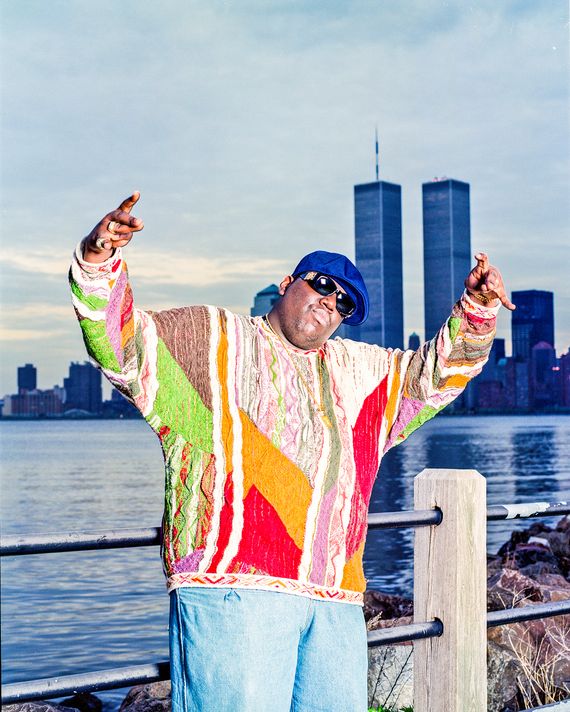
56. Run-D.M.C., “It’s Tricky” (1987)
Rick Rubin flipped the Knack’s “My Sharona” for this Über-catchy single, one of the standouts in Run-D.M.C.’s oeuvre, from their multiplatinum smash Raising Hell. The video was a fixture on MTV, as Run and DMC make it clear that being rap superstars ain’t ever been easy. —Stereo Williams
55. Smif-N-Wessun, “Bucktown” (1994)
This song sounds like riding the 3 train through Brooklyn in the early ’90s. Smif-N-Wessun had a knack for slipping in and out of patois, as they rapped over jazzy grooves courtesy of Da Beatminerz. The duo, comprised of Tek and Steele, christened Brooklyn with the nickname “Bucktown” as they kicked the gospel about gunplay and hardcore happenings from the home of the “originoo gunn clappaz” (that’s “original gun clappers,” but you have to say and spell it N.Y.-style) and painted a vivid description of street life in a rougher version of Brooklyn that existed before the hipster takeover, when Myrtle Avenue was known by locals as “Murder Avenue.” —Starr Rhett Rocque
54. Azealia Banks, “212” (2011)
In New York, your area code is just as fundamental to your hometown pride as any other locality marker. No one knows that better than Harlem-raised Azealia Banks, who wrote the hit in reference to Manhattan’s premier three digits while living on Dyckman. Banks burst onto the scene at the top of the decade as a boundary-breaking force, interpolating her skillful raps with beat structures emerging from ballroom culture — no one else does Hot 97 Summer Jam and Mermaid Ball in the same day — while sharing just a flash of the vocal dexterity that is part and parcel of her avant-garde sonic universe. —Shamira Ibrahim
53. Raekwon, “Ice Cream” (1995)
Wu-Tang Clan weren’t exactly known for their songs about women, but they made a classic sex cut with this group effort for Raekwon’s seminal solo debut, Only Built 4 Cuban Linx... Rae, Ghostface Killah, and Cappadonna each spit their game at ladies as Method Man compares them to different ice-cream flavors, all over a characteristically sparse soundbed by RZA. —William E. Ketchum III
52. The Notorious B.I.G., “Who Shot Ya” (1994)
“Who Shot Ya” sounds exactly like a track that accidentally launched rap’s biggest feud between Biggie and Tupac. It’s dark, menacing magic. Biggie’s delivery is methodical, as each line hits with seemingly casual potency. Biggie has bigger tracks and more impressive lyrics, but this is him and producer Nashiem Myrick at their Brooklyn finest, with Puff at his ad-lib finest, elevating it to an anthemic level. —Naima Cochrane
51. Cam’ron and Juelz Santana, “Oh Boy” (2002)
Cam’ron’s 2002 Roc-A-Fella debut, Come Home With Me, introduced the Diplomats to the world. Harlem’s finest earned a Grammy nomination with the single “Oh Boy”— the song that was never supposed to exist. Cam’s hit over the stolen Just Blaze beat, originally made for Memphis Bleek, earned a No. 1 spot on the Hot R&B/Hip-Hop Songs chart for five weeks straight and a series of remixes by the likes of Mariah Carey and Jay-Z, whose recording contained a Nas diss that was infamously shelved. —Ivie Anie
50. Digable Planets, “Rebirth of Slick (Cool Like Dat)” (1993)
Though not the first to fuse jazz and hip-hop, few before or after did so with such reverent respect for the source material. Anchored by late-’70s Jazz Messengers bassist Dennis Irwin’s groove, the trio’s rhymes propagated downtown cool with an Afrocentric aim. —Gary Suarez
49. Black Star, “Definition” (1998)
When the burgeoning shiny-suit era had some hip-hop fans disenchanted in the late ’90s, the Black Star duo of Mos Def (known now as Yasiin Bey) and Talib Kweli (and their label home, Rawkus Records) represented a return to what made the art form so special in the first place: empowering, thoughtfully crafted rhymes and kinetic energy. —William E. Ketchum III
48. Ja Rule ft. Fat Joe and Jadakiss, “New York” (2004)
In 2004, hip-hop wrote off Ja Rule after 50 Cent’s assertions that he focused too much on sweet radio songs. So for the second single of his album R.U.L.E., Ja called on two of NYC’s most respected vets, Fat Joe and Jadakiss, for an anthem that referenced KRS-One’s 1990 song “100 Guns” while paying homage to the hard-core hip-hop that runs through the city’s veins. —William E. Ketchum III
47. Nas, “The World Is Yours” (1994)
Like most of Illmatic, the lyrics to “The World Is Yours” would look almost impossibly dense written down; on record, they breathe and bend and spring to life like nearly everything Nas made in that blessed early period. And though he was 20, he was already mining the past: the hook scratches in “It’s Yours,” T La Rock’s classic single from 1984. —Paul Thompson
46. Foxy Brown, “Ill Na Na” (1996)
“Ill Na Na” is a lightning-in-a-bottle moment in hip-hop. It’s like listening to a time capsule where Foxy — a spitfire out of Brooklyn who stunned the scene with her verse on LL Cool J’s “I Shot Ya (Remix)” as a teenager — and Lil’ Kim are still friends and collaborators, and women were going platinum off physical sales on their debut albums. A brazen Inga Marchand made her stamp, inverting misogynist tropes into husky, unapologetic rejoinders anchored by the closest approximation of a heartthrob in ’90s rap, Method Man. —Shamira Ibrahim
45. Kool G Rap & DJ Polo, “Streets of New York” (1990)
It sounds like walking the block on a windy night in the winter. G Rap is the father of NYC street rap, and no song captures the essence better. The legendary rhymer sets a blueprint for grimy storytelling, and the production set a standard for ’90s hard-core. —Stereo Williams
44. Black Moon, “I Got Cha Opin” Remix (1994)
This track sounds like bubble coats, Avirex jackets, Polo Ranger boots, Timberland 40 Belows, and Dutch Masters. Black Moon made underground hip-hop that unintentionally found its way to the light thanks to Da Beatminerz’ grimy but smooth production on Enta da Stage. “I Got Cha Opin” was a brief walk down Boot Camp Clik’s shadowed sonic streets, an escorted journey to the darker side. —Naima Cochrane
43. Slick Rick, “Children’s Story” (1989)
This track is the foundation of storytelling in hip-hop, a casual tale of cops and robbers that could be placed in any of the five boroughs. In these four minutes with no chorus, a 17-year-old is pulled into a life of crime before facing the consequences. “The cops shot the kid / I still hear him scream,” Slick Rick says. —Eric Diep
42. Big Daddy Kane, “Ain’t No Half Steppin’” (1988)
Marley Marl and Big Daddy Kane worked magic in the studio, and this single may be their best work. It’s Kane in full laid-back mack-daddy mode but offering some of his most nimble rhymes. For an artist who always walked the line between romantic ladies’ man and rhyme animal, it’s his best showcase. —Stereo Williams
41. Jay-Z, “Dead Presidents II” (1996)
Jay-Z came out of the shadows of Jaz and Big Daddy Kane to boss up, forming his own label, Roc-A-Fella Records, in 1995 and releasing his layered debut, Reasonable Doubt, the following year. “Dead Presidents II” is the finest example of Hov’s early allure as a mafioso rapper who could create a gritty atmosphere in his pursuit of material possessions. —Eric Diep
40. Public Enemy, “Rebel Without a Pause” (1988)
It’s like a piercing siren announcing a coming crisis. Public Enemy has bigger songs, but no track is more quintessentially P.E. It summarizes everything great about the Bomb Squad, with Chuck D coming from a lower level and Flavor Flav riding shotgun. —Stereo Williams
39. Jadakiss ft. Styles P, “We Gonna Make It” (2001)
The Alchemist beat, Jadakiss and Styles P’s back and forth, Eve on the remix. “We Gonna Make It” comes from the height of Ruff Ryders’ domination, serving up an iconic Jada opener: “Fuck the frail shit, ’cause when my coke come in / They gotta use the scale that they weigh the whales with.” White-linen music. —Eric Diep
38. Busta Rhymes, “Put Your Hands Where My Eyes Could See” (1997)
You can’t talk about Busta Rhymes without talking about the music videos, and his visual for this single from his 1997 album When Disaster Strikes… is a masterpiece. Inspired by the song’s African-sounding drums, Busta and director Hype Williams pay homage to the Eddie Murphy film Coming to America with tribal glow paint and ornate décor. And Busta’s all-time-great dynamic flows and personality carry over in the speakers even when the TV is off. —William E. Ketchum III
37. Mobb Deep, “Quiet Storm, Pt. 2” (1999)
“Quiet Storm” appeared on Mobb Deep’s Murda Muzik and the soundtrack for In Too Deep, but the remix is an all-time great. Havoc’s cavernous production is a perfect canvas for his and Prodigy’s crime bars, and Lil’ Kim spits one of her hardest, most no-nonsense verses ever. “My Brooklyn style speak for itself,” she righteously insists. —William E. Ketchum III
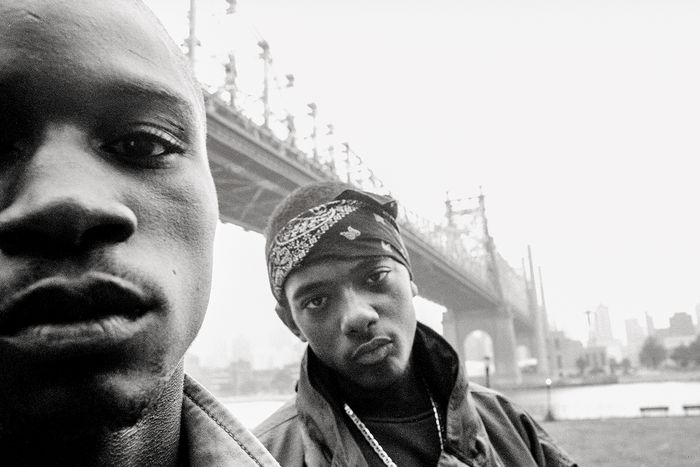
36. MC Lyte, “Ruffneck” (1993)
Rap owes a great debt to MC Lyte. Sure, Salt-N-Pepa normalized women who rap, specifically women who rap about sex, but Brooklyn’s own MC Lyte came marching at you from a rooftop overlooking the Manhattan Bridge, rapping about needing a “dude with a attitude” who’ll “smack it, lick it, swallow it up style,” dressed from head to toe exactly like one of the boys she’s trying to bed. Its superior swag and male-gazing set the standard for what women were “allowed” to rap about, and generations of New York rappers followed her lead (see: Nicki Minaj, Cardi B, Foxy Brown, Lil’ Kim). —Dee Lockett
35. Lost Boyz, “Jeeps, Lex Coups, Bimaz & Benz” (1995)
Lost Boyz mastered the art of balancing grimy street appeal with infectious hooks, and they showcase their winning formula on this classic single. It’s pure Queens and one of the best examples of Mr. Cheeks’s charismatic flow and the always-inspired production of Easy Mo Bee. —Stereo Williams
34. The Diplomats, “Dipset Anthem” (2003)
Jaws works because you don’t see the shark right away. Similarly, “Dipset Anthem” is massive and propulsive, driven by the Heatmakerz and those two near-percussive verses by Juelz Santana. But it’s Cam’ron’s turn in the third verse — sly, playful, sinister as ever — that makes this one of the most iconic records of the early aughts. —Paul Thompson
33. Cardi B, “Bodak Yellow” (2017)
When Cardi B used Kodak Black’s “No Flockin” flow for “Bodak Yellow,” her magnetic confidence gave the song the edge it needed to blow up. After beating out Lauryn Hill’s “Doo Wop (That Thing)” to have the longest-running No. 1 by a solo female rapper on the Hot 100, Cardi B signaled a new era for rap: one where there can be more than one female superstar at the top. —Eric Diep
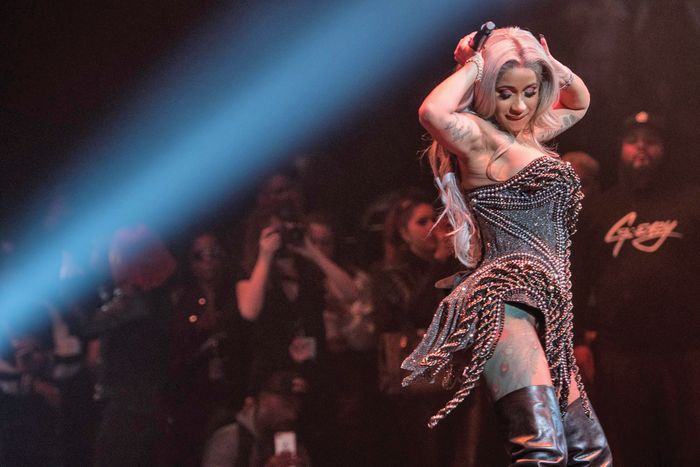
32. LL Cool J, “Mama Said Knock You Out” (1991)
His 1989 album Walking With a Panther was successful, but the Queens legend was accused of being out of touch in the era of Public Enemy and N.W.A. LL fired back with this Marley Marl–produced bomb, a declaration of dominance and creative focus as a new decade dawned. —Stereo Williams
31. Nas, “Ether” (2001)
Jay-Z vs. Nas was a legendary war of words. When Jay-Z dropped “Takeover” and Nas responded with “Ether” (which debuted on Hov’s birthday), the exchange marked two great MCs battling for New York supremacy. Nas’s attacks were personal, effectively hurting Jay’s ego. Thanks to Nas, since then no beef is considered won unless you “ether” your opponent. —Eric Diep
30. Juice Crew, “The Symphony” (1988)
Producer Marley Marl assembled three of the best MCs in the game — Big Daddy Kane, Kool G Rap, and Craig G — along with newcomer Masta Ace for this mic battle royal. “The Symphony” established the Juice Crew’s dominance as a rap collective, but Marley created a new rap art form: the posse cut. —Naima Cochrane
29. Eric B. & Rakim, “Paid in Full” (1987)
Rakim has never wavered. When Marley Marl invited the precocious teenager into his home studio and suggested Rakim rap more animatedly, the young MC held firm, insisting that steely cool was his greatest asset. He was right: The title track from Paid in Full is a study in poise — and in the labyrinthine internal rhymes Rakim pioneered. —Paul Thompson
28. Puff Daddy ft. Lil’ Kim, the LOX, and the Notorious B.I.G., “It’s All About the Benjamins (Remix)” (1997)
The jiggy era dealt in brain-freezing excess — from motorboat chase sequences in music videos to samples of disco hits that must have cost a small fortune. “It’s All About the Benjamins (Remix)” epitomizes this in its barrage of threats and big-money bragging and that clever Jackson 5 flip. It’ll light any tristate-area party on fire to this day. —Craig Jenkins
27. The Diplomats, “I Really Mean It” (2003)
Roc-A-Fella’s Just Blaze was among the producers revolutionizing the sped-up soul samples that became popular in the aughts. The Diplomats’ debut album, Diplomatic Immunity, owned this sound, and “I Really Mean It” is Harlem’s rallying cry to rep your hood proudly, with Cam’ron’s opening shout-outs setting the tone for a powerful crew salute. —Eric Diep
26. Audio Two, “Top Billin’” (1987)
Simple track, simple rhymes: the components of a foundational classic. The “Impeach the President” flip has remained a no-miss sample over the years, most notably with Mary J. Blige and the Notorious B.I.G.’s “Real Love.” The oft-repurposed formulation “___ is chillin’, ____ is chillin’” still delivers concise B-boy realness. —Naima Cochrane
25. Lil’ Kim, “Crush on You” (1996)
Stepping out from Junior M.A.F.I.A. with the mentorship of the Notorious B.I.G., Kim sought to continue to subvert the expectations of women in rap with the unblushing, aggressive lyricism of her debut solo album, Hard Core. “Crush on You” made it clear that her role was not to follow a blueprint but to stencil a new template — joining forces with stylist Misa Hylton to pair her and Lil’ Cease’s lavishly bawdy verses with richly pigmented ensembles and visuals, down to the matching wigs. With one video, Kim melded street fashion with hip-hop on the mainstream stage. —Shamira Ibrahim
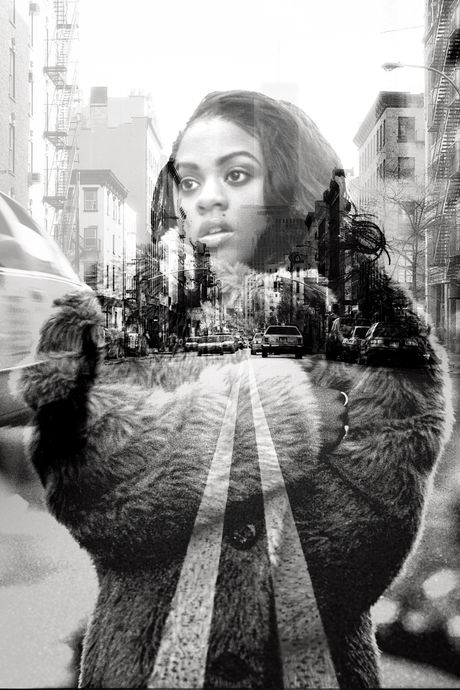
24. Pop Smoke, “Dior” (2019)
Pop Smoke’s tragic death in February 2020 shook New York harder than his meteoric impact on the scene already had. His borderless Brooklyn drill sound became the fresh, defining music of New New York, and “Dior” was his most ubiquitous single (though amazingly not his only; see “Welcome to the Party” above). During a summer of national uprisings, it has become the city’s movement music, finding its way from dance floors to the protests’ front lines. —Ivie Anie
23. Method Man ft. Mary J. Blige, “I’ll Be There for You/You’re All I Need to Get By” (1995)
Rap’s preeminent love song started as a rougher, grimier product on Method Man’s Tical. By adding hip-hop’s Tammi Terrell in Mary J. Blige, mixes from both RZA and (then) Puff Daddy added softness to balance the edge, broadening the appeal from the slums to the suburbs and earning both Meth and Mary their first Grammys. —Naima Cochrane
22. Ol’ Dirty Bastard, “Brooklyn Zoo” (1995)
Drawing upon his idiosyncratic “Protect Ya Neck” verse, Wu-Tang’s rowdiest MC unleashes his fury over a dissonant True Master beat. Rhyming “Midol” with “Lysol” for the first and probably only time in rap history, he created a haven for eccentrics in the city’s rap landscape for decades to come. —Gary Suarez
21. Pete Rock & C.L. Smooth, “They Reminisce Over You (T.R.O.Y.)” (1992)
A timelessly winsome track that perfectly captures nostalgia: Pete Rock and CL Smooth dedicated this Tom Scott–sampling song to the late Trouble T Roy, celebrating family and friends, immortalizing their fallen comrade, and elevating the Mount Vernon duo to legend status. —Stereo Williams
20. Onyx, “Slam” (1993)
Before Onyx, Queens representatives such as LL Cool J and even Run-D.M.C. were swaggy and cool. But then this group from South Jamaica came storming in with baggy jeans, Timberlands, and bald heads. Their mosh-pit energy, coupled with their frenetic, testosterone-fueled delivery, made everyone want to be a boy. —Starr Rhett Rocque
19. Gang Starr, “Mass Appeal” (1994)
“Mass Appeal” sounds like you’ve made it to the final level of a video game and the big boss simply wishes you had some dignity. Guru was one of the most self-possessed rappers to ever touch a mic — here he famously touts his “monotone style” — and DJ Premier takes aim at the radio, bending its sounds into something richer, heavier, meaner. —Paul Thompson
18. Slick Rick and Doug E. Fresh, “La Di Da Di” (1985)
Doug E. Fresh was already a name when he plucked a young Bronx-by-way-of-Britain rhymer named MC Ricky D to join his Get Fresh Crew. This 1985 single highlights their perfect chemistry and announced the storytelling talent of the MC soon-to-be-crowned Slick Rick. —Stereo Williams
17. Lord Tariq & Peter Gunz, “Déjà Vu (Uptown Baby)” (1998)
There’s a sense in which “Déjà Vu (Uptown Baby)” is the commercial promise of hip-hop realized: Lord Tariq and Peter Gunz lift a Steely Dan song nearly wholesale, rap pridefully about how the Bronx can’t be fucked with, and end up with a top-ten hit. Although the duo broke up just a couple of years after the song’s release, it still signals the arrival of summer from open car windows. —Paul Thompson
16. Big Pun ft. Joe, “Still Not a Player” (1996)
Among the many gifts with which Christopher Rios, better known as Big Pun, blessed New York City, dropping the biggest Latinx hip-hop anthem of all time, addressing the Boricuas and Morenas with shout-outs and swagger, ranks highest. —Gary Suarez
15. DMX, “Ruff Ryders’ Anthem” (1998)
In the late ’90s, Ruff Ryders established themselves as the direct opposite of Puff Daddy’s Bad Boy: They ditched the shiny suits for motorcycles, bandannas, and pit bulls. “Ruff Ryders’ Anthem” took that rugged aesthetic to a whole new level, as DMX spoke for the streets, creating a worldwide Double R dedication. —Eric Diep
14. Terror Squad, “Lean Back” (2004)
After Cuban Link and Triple Seis departed from Terror Squad acrimoniously, the reconstituted Bronx squadron leaned into Fat Joe’s pop-rap pocket and pulled out a chart-topping Hot 100 smash. The distinctive beat from producer Scott Storch energized the city and did big things for the producer, who subsequently made hits for 50 Cent and Jadakiss. —Gary Suarez
13. Public Enemy, “Fight the Power” (1989)
Chuck D dissing Elvis and John Wayne, two American icons, coupled with Flavor Flav’s ad-libs and the frantic-yet-brilliant Bomb Squad production borrowing from James Brown, the Isley Brothers, and Syl Johnson, made a powerful statement: PE loved Black people and wanted to provoke a new generation of freedom fighters. They represented elements of their passion for the culture in the song’s sample choices, but also in the call out to “fight the power.” (Public Enemy also lifted that phrase from the Isley Brothers song of the same title.) Their classic was originally crafted as an anthem for Spike Lee’s Oscar-nominated film, Do the Right Thing (Lee also directed the Brooklyn-shot video). It was also featured on Public Enemy’s third studio album, Fear of a Black Planet, which came out the following year, and still resonates as one of the greatest protest anthems of all time. —Starr Rhett Rocque
12. Craig Mack, “Flava in Ya Ear” Remix (1994)
Puff Daddy established his remix expertise at Uptown Records, but the formidable additions of label mate the Notorious B.I.G., upcoming rappers Rampage and Busta Rhymes, and OG LL Cool J to Craig Mack’s “Flava in Ya Ear” — showcased with Hype Williams’s now-iconic black-and-white visuals — turned remixes into an event, poised B.I.G. for launch, and handed a still-new Bad Boy the crown. —Naima Cochrane
11. A Tribe Called Quest, “Scenario” (1992)
This is peak NYC Golden Era hip-hop on what is one of the greatest posse cuts of all time. On “Scenario,” A Tribe Called Quest and Leaders of the New School deliver a dizzying array of lyrical acrobatics in a way that was still new to hip-hop at that time, showing new possibilities with flows and rhythms. Phife Dawg did what he does best by tossing in the obnoxiously sexual but clever line, “Bust a nut inside your eye to show you where I come from,” while Busta Rhymes set the world up for what his solo career would sound like with an animated verse complete with grunts and dragon roars blended into the rhymes, along with an oddball reference to “old stale urine.” Busta’s fiery flow, and cartoonish larger-than-life personality became the founding elements of fast-paced rapping as well as rap alter-egos — concepts later expanded on by the likes of Tech N9ne and also Nicki Minaj, who borrowed Busta’s dungeon dragon line for her own song, “Roman’s Revenge.” —Starr Rhett Rocque
10. Roxanne Shanté, “Roxanne’s Revenge” (1984)
There is no discussion of the art of rap without Roxanne Shanté and the notorious Roxanne Wars, which ran from 1984 to 1985. It’s the stuff of Queensbridge Houses lore: Not long into the infancy of rap, those who’d picked it up as a hobby swiftly and masterfully turned it into sport. As history (and the 2017 biopic Roxanne Roxanne) tells it, Brooklyn rap group UTFO put out a viral (by 1984 standards) song called “Roxanne, Roxanne,” which chastised a young woman named Roxanne for not giving them the time of day. Enter a then-14-year-old rap prodigy named Roxanne Shanté who’d overheard radio DJ Mr. Magic and Marley Marl gossiping about UTFO bailing on one of their gigs. So she volunteered to drag the group to hell and back using a sample of their own record. Famously freestyled and recorded in one take, “Roxanne’s Revenge” birthed a true culture war that inspired anywhere from 25 to 100 response records (including from UTFO and an artist they tried to pass off as “the Real Roxanne”) as word of the assassinating track spread through the boroughs. (You could say it invented rap’s diss economy.)
The track led to UTFO’s label, Select Records, copyright-claiming the sample — one of the earliest cases of rap getting litigious — and forcing Shanté to remove it (and her many expletives) from later releases. In one deadly line, Shanté turns the rap game on its head: “He said, ‘You call yourself an MC?’ I said, ‘This is true.’ He said, ‘Explain to me really what MCs must do.’ ” She follows it up with a rap clinic, one that godfathered “Ether,” “Takeover,” and every other feud on wax that gets more credit for doing what Roxanne did first. —Dee Lockett
9. M.O.P., “Ante Up (Robbin Hoodz Theory)” (2000)
Despite this song’s unapologetic violence and the Brownsville, Brooklyn, duo M.O.P. being the furthest thing from mainstream rap stars, “Ante Up” became ubiquitous: It has appeared or been sampled in films and TV shows, was adopted as superstar wrestler John Cena’s theme song, and even prompted a performance by Anna Kendrick on Ellen. Lil’ Fame and Billy Danze’s ode to armed robbery, with its shouted raps and frenetic alarm-sounding production by DR Period, packs an energy that continues to shake you long after its final note. Hip-hop is all about taking what’s yours, and no song in the genre embodies that spirit more. Extra points for the remix, which features equally urgent verses by Busta Rhymes, Remy Ma, and Teflon. —William E. Ketchum III
8. & 7. MC Shan, “The Bridge” & KRS-One, “The Bridge Is Over” (1986/1987)
You can’t talk about defining beefs in hip-hop, period (especially in NYC rap), without mentioning these songs, and you definitely can’t talk about one without the other. Together, they set the precedent for lyrical beef in the culture. Regional pride in hip-hop always comes with a side of ego, so when MC Shan released “The Bridge,” produced by his cousin Marley Marl, in 1986, his point was to tell the world about where he was from: the notorious, sprawling Queensbridge Houses, an area that holds just as much stake in birthing hip-hop as the Bronx does. (It’s so big it could be its own small city, and is home to several rap legends like Roxanne Shanté, Marley Marl, Nas, Mobb Deep, and more.)
However, people in the city are territorial, and KRS-One, who hails from the South Bronx, vented his frustrations on “The Bridge is Over,” calling out MC Shan as well as several other members of the Juice Crew, and asserting his dominance. And that is how the Bridge Wars — the battle over who was the best between Boogie Down Productions and the Juice Crew — were born. (These aren’t the only songs that were part of the battle; MC Shan’s “Kill That Noise” and BDP’s “South Bronx” are two more examples out of over a dozen more.) The back and forth lasted until summer 1990, when BDP got the last word on “Black Man in Effect,” where KRS-One references how he’s not down with the Juice Crew. The Bridge Wars have long since been (mostly) squashed, but they live forever in hip-hop history books. —Starr Rhett Rocque
6. Bobby Shmurda, “Hot N—–” (2014)
When you watch the video for Bobby Shmurda’s “Hot Nigga” in 2020, it sounds like it could’ve been released yesterday. The Brooklyn rapper, with his undeniable charisma and star power, was going viral in 2014 before Fivio Foreign made it hip to say that. As Shmurda finishes a lengthy seven-year sentence for gang conspiracy and gun charges, New York DJs have made sure he’s remained relevant. “Hot Nigga” was influenced by Chicago drill and southern trap, with the kind of rhythmic and lyrical aggression typified by GS9, the East Flatbush gang Shmurda’s a part of. It’s a song that fits with the Brooklyn drill movement pulsing through the neighborhood streets right now: menacing and boisterous, taking it to the pavement instead of the high-rises. Before TikTok existed, he famously made people do Vines tossing their hats in the air and hitting the Shmoney Dance. A clip from those remains a time capsule of Shmurda’s mainstream rise — a rapper who’d barely peaked before he went to prison (arguably thanks to the song in question), and whose return is one of rap’s most anticipated. —Eric Diep
5. Wu-Tang Clan, “C.R.E.A.M.” (1994)
Wu-Tang Clan is more than just the greatest rap group of all time; it’s virtually a belief system — and if that’s the case, “C.R.E.A.M.” is one of its mottos. The acronym stands for “Cash rules everything around me,” and it didn’t become lingo for money just because it rolls off the tongue. The brainchild of producer-rapper RZA came with a gritty, dungeon-dwelling sound and a crew of rappers who describe their lives of crime with candor, sharpness, and one of the most diverse assortments of personalities rap had ever seen. This song and the album Enter the Wu-Tang (36 Chambers) set the stage for a flood of street rappers from NYC to build on Wu-Tang’s successes, while the group itself would divide and conquer, creating solo stars before coming back together to continue its collective dominance. —William E. Ketchum III
4. Nas, “N.Y. State of Mind” (1994)
The first full song from Nas’s 1994 album Illmatic shows why hip-hop saw him as the ’90s successor to ’80s architect Rakim. It was more than the intricate rhyme schemes and flows: His portrayal of his Queens housing project is visually vivid and physically palpable. While outsiders may associate NYC with the glitz of Times Square, Nas thinks of crime: shoot-outs with police, armed robberies in broad daylight, zombified drug addicts. A prodigious 20-year-old Nasir Jones dropped a different image or adage for survival (“I never sleep, ’cause sleep is the cousin of death”) in seemingly every line of his extended verses. DJ Premier’s beat, a grim soundbed with a lurking bass line, a haunting piano key, and a Rakim sample in its chorus, is an equally bleak match for Nas’s rhymes. It’s one of the earliest defining images of the NYC that rappers would chronicle for decades with both desperation to escape and pride for home. —William E. Ketchum III
3. The Notorious B.I.G., “Juicy” (1994)
NYC is the birthplace of hip-hop, but when Death Row Records was dropping record-breaking albums in the early ’90s, L.A. had the hot hand. As he’d say years later, the Notorious B.I.G. wanted “to sell records like Snoop” — and with “Juicy,” he made his mark. Before signing to Bad Boy Records, Brooklyn’s Christopher Wallace had sold drugs, his mama had cancer in her breast, and his first child was on the way. “Juicy,” the first single from his debut, Ready to Die, is hip-hop’s definitive declaration of the American Dream: Biggie’s perseverance through crime, unpaid bills, and disparaging teachers to achieve wealth and appreciation of his talents. As much as his own success, the song celebrated hip-hop’s arrival as an artistic and cultural force. And Sean “Diddy” Combs’s decision to use the vibrant sample from Mtume’s 1983 jam “Juicy Fruit” provided familiar, timeless warmth. “Juicy” peaked at No. 27 on the Billboard Hot 100, Ready to Die went double platinum a year after its release, and the song still captures rap at its most aspirational. Biggie was King of New York, and “Juicy” was his throne. —William E. Ketchum III
2. Grandmaster Flash & the Furious Five, “The Message” (1982)
Co-produced by Sugar Hill’s in-house hitmaker Clifton “Jiggs” Chase, this was written by Melle Mel and another Sugar Hill mainstay, Duke Bootee, and would go on to become the definitive track of hip-hop’s first wave. It’s a vivid storytelling masterpiece that effectively captures the nervous energy of Reagan-era NYC streets.
If hip-hop has a “Johnny B. Goode,” this 1982 single has to be it. The rhythm guitar pulses throughout, and the bass-and-synth backdrop is immediately recognizable, and you’d be hard pressed to find someone who can’t finish the opening “Broken glass everywhere” bars. It lyrically channels a New York City still covered in some ’70s grit, while also sonically reaching for a distinctly ’80s sheen.
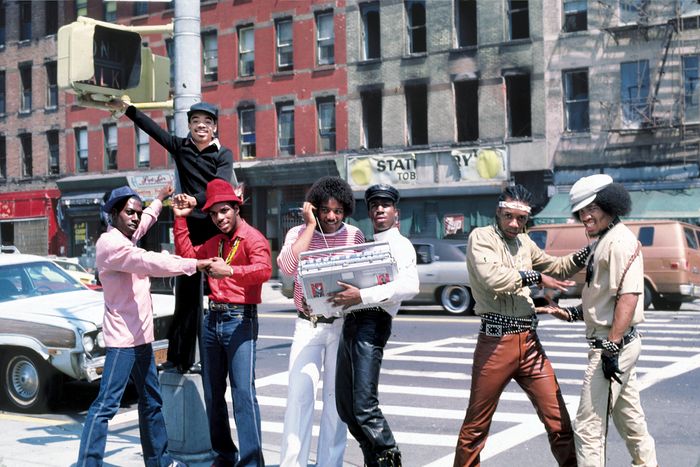
Sugar Hill Records released a number of indelible records and helped shape early hip-hop’s transition from the park to the studio. No song embodies that shift better than “The Message.” Co-produced by Sugar Hill’s in-house hitmaker Clifton “Jibbs” Chase, this hit was written by Melle Mel and another Sugar Hill mainstay, Duke Bootee, and would go on to become the definitive track of hip-hop’s first wave. It’s a vivid storytelling masterpiece that effectively captures the nervous energy of Reagan-era NYC streets. —Stereo Williams
1. Mobb Deep, “Shook Ones, Pt. II” (1995)
Havoc was barely 20 years old, sitting alone at his mother’s apartment in the Queensbridge housing projects, reeling from the flop of his debut album, when he warped a piano line from Herbie Hancock’s “Jessica” to sound like it was beckoning the listener into hell. Every word uttered on “Shook Ones, Pt. II” would become iconic, from Prodigy’s opening ad-libs (“To all the killers and a hundred-dollar billers”) to Havoc’s desperate self-examination (“Do I deserve to live?”), from the warm hearts turned cold to the nose bones turned shiv. It’s a note-perfect mission statement for one of the genre’s greatest acts, referenced ad nauseam but never replicated.
The song transformed Mobb Deep’s career by doing what New York rap has done so grippingly since “The Message”: It throws floodlights into the city’s darkest corners, rendering them with unnerving detail and inimitable style. To say it’s rooted in one place would be a staggering understatement. “Shook Ones” is such a product of its environment that the hi-hats aren’t hi-hats at all, but rather the arthritic sounds of Queensbridge’s stove-top elements sparking to life. And as bone-chillingly grim as Mobb Deep’s music could be, it was also marked by neighborhood pride. “If I die,” Prodigy raps in the song’s opening verse, “I couldn’t choose a better location.” —Paul Thompson
*A version of this article appears in the September 14, 2020, issue of New York Magazine. Subscribe Now!
Source images (photo-illustration): KMazur/WireImage, Theo Wargo/WireImage, Dave Allocca/DMI/The LIFE Picture Collection via Getty Images, YouTube, ITV/Shutterstock, Jeff Kravitz/FilmMagic, Film Four/Lafayette/Kobal/Shutterstock, Al Pereira/Michael Ochs Archives/Getty Images, Neilson Barnard/Getty Images, Mike Pont/FilmMagic and Kevin Kane/WireImage